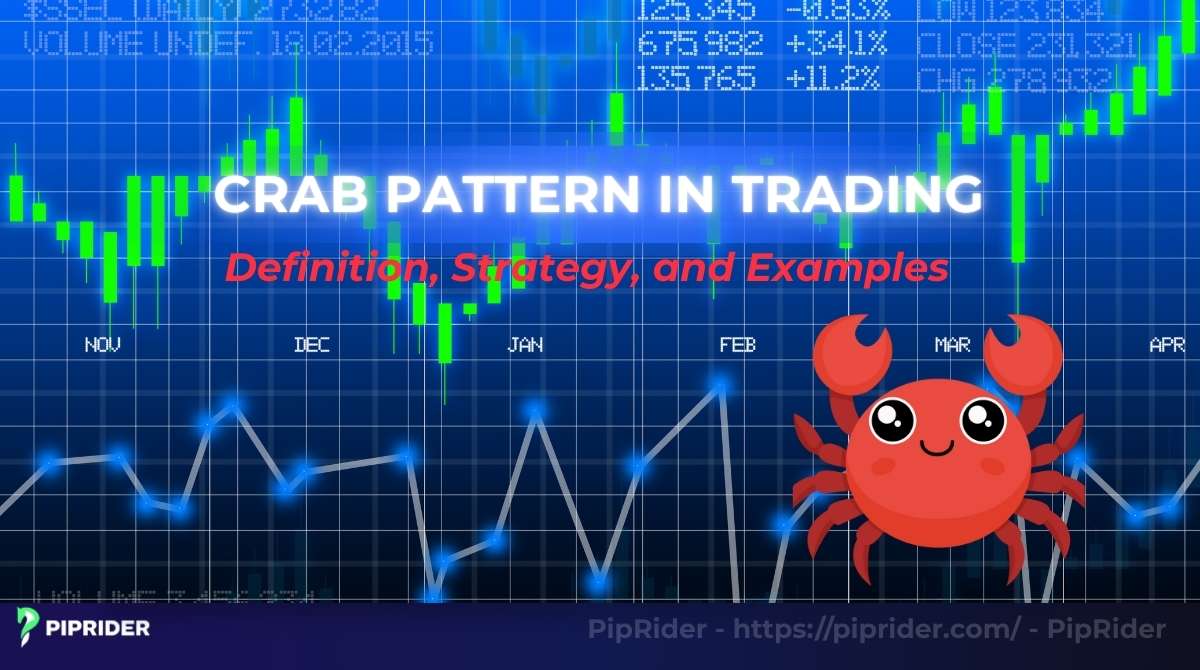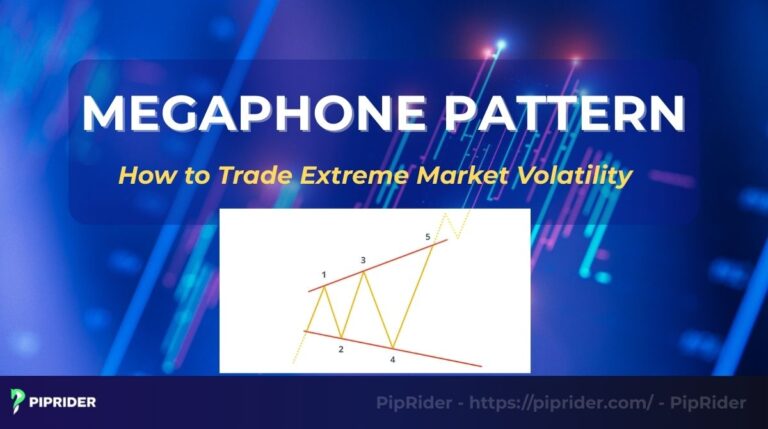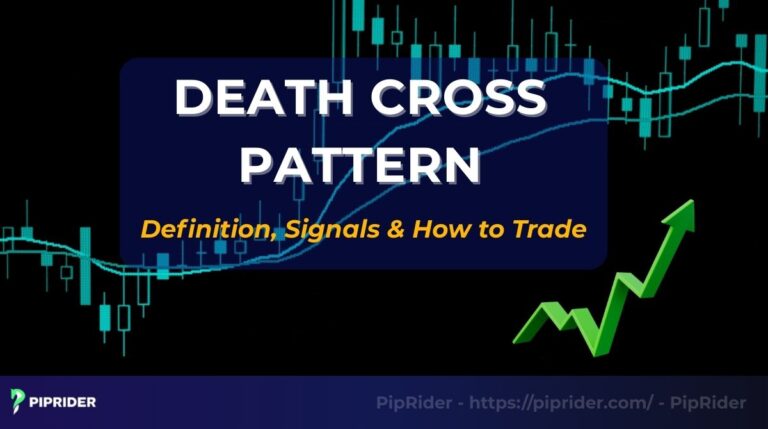Have you ever seen a market make an extreme, seemingly overextended move and wondered where it might finally reverse? The Crab pattern is an advanced harmonic structure designed to identify exactly these potential turning points.
This guide will break down what this chart pattern is, how to identify its unique structure, and the strategy for trading it effectively.
Key Takeaways
- A five-point harmonic pattern that signals high-probability reversals at extreme price action levels.
- Comes in two forms: a Bullish Crab (signaling a bullish reversal) and a Bearish Crab (signaling a bearish reversal).
- Defined by a critical 1.618 Fibonacci extension levels of the initial XA leg.
- Provides a clear trading plan with a precise entry zone (PRZ) and risk management levels.
- Applicable in the stock market, forex, and crypto.
1. What Is the Crab Pattern?
The Harmonic Crab Pattern is a precise five-point (XABCD) extension pattern used in technical analysis to identify potential trend reversal at extreme price levels. Scott Carney discovered this pattern in 2001, and it is considered one of the most powerful and accurate harmonic patterns due to the unique price structure.

Its defining characteristic is an extremely long CD leg that extends to a 1.618 Fibonacci projection of the initial XA move. This structure pinpoints areas where a trend has become overextended and exhausted. The reason it’s considered so powerful is that such extreme moves often result in a very sharp and rapid reversal as the market “snaps back” from these unsustainable price action levels.
2. Key Components of the Crab
The Crab pattern is defined by a five-point structure (X, A, B, C, D) that creates four distinct price swings or “legs.” Understanding these components and their specific Fibonacci ratios is essential for accurate identification.
What truly defines this pattern are its unique and non-negotiable Fibonacci ratios. The AB leg must retrace between 0.382 and 0.618 of the XA leg, followed by an extreme BC leg extension. Most critically, the final CD leg completes at a 1.618 extension of the XA leg, forming the Potential Reversal Zone (PRZ). This represents a multi-legged retracement.
The pattern has two variations that signal opposite moves:

- A Bullish Crab forms a shape resembling a “M” at the end of a downtrend, signaling a potential price reversal to the upside.
- A Bearish Crab forms a shape resembling an “W” at the end of an uptrend, signaling a potential price reversal to the downside.
3. How to Identify the Crab Pattern on Charts
Identifying a valid Crab pattern is a process of confirming both its visual shape and its precise Fibonacci measurements. Here’s a simple checklist for spotting a high-probability setup.
First, visually scan the chart for the distinct extended “M” shape (for a Bullish Crab) or “W” shape (for a Bearish Crab). The key visual clue is that the final CD leg is much longer than the other legs, extending far beyond the pattern’s starting point X. This is a crucial element of price action analysis.
Next, and most critically, use Fibonacci tools to validate the pattern’s ratios. The setup is only a valid Crab pattern if the D point completes at or very near the 1.618 extension of the initial XA leg. This non-negotiable measurement is what separates the Crab from other formations such as the cup and handle pattern and other harmonic patterns.
Finally, a high-probability setup is often confirmed by other signals. Check if the Potential Reversal Zone (PRZ) at point D aligns with a key support or resistance level, or if an oscillator like the RSI is showing divergence. These factors enhance the trading opportunities.
4. How to Trade the Crab Pattern
Trading the Crab pattern successfully requires a disciplined, rule-based approach. Once a valid pattern is identified, the next step is to create a clear plan for your entry, stop-loss, and profit objectives.
4.1. Entry and Exit Strategy
The entire trading strategies for this pattern revolves around the Potential Reversal Zone (PRZ) at point D. Here’s a breakdown of the standard rules:
- Entry Point (at the PRZ): The trade is entered when the price reaches the 1.618 extension of the XA leg, which defines this zone. As this represents an extreme level, many traders await a confirmation candle (like a pin bar or engulfing candle) to form within the Potential Reversal Zone before executing a market order. More cautious traders might opt to set a limit order slightly inside the PRZ, or following the confirmation candlestick, to secure a precise entry price.
- Stop-Loss Placement: The stop-loss is positioned just beyond the Potential Reversal Zone. For a Bullish Crab, this is set a few pips below point D, while for a Bearish Crab, it’s placed slightly above that same point. This strategic positioning invalidates the trade if the extreme move continues.
- Profit Targets: Common values are set at the 0.382 and 0.618 Fibonacci retracement levels of the move from point A to point D. Traders often take partial profits at the first target and move their stop-loss to breakeven. This helps manage the risk/reward ratio.
4.2. Bullish Crab Strategy
A Bullish Crab is a powerful reversal pattern that appears at the end of a prolonged downtrend. The strategy is to identify the point of seller exhaustion and enter a long (buy) trade, anticipating a sharp reversal to the upside.
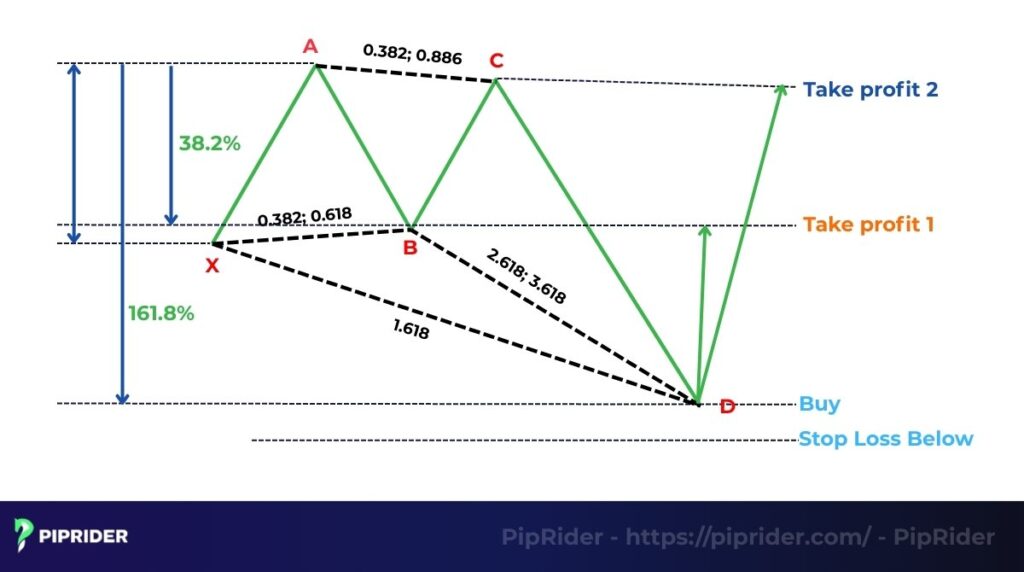
Example: The Case of the Exhausted Bears (MSFT Stock)
A trader spots a clear “M” shape on the Microsoft ($MSFT) chart after a long downtrend. The final leg of the pattern plunges sharply, signaling seller exhaustion. As the price enters the key reversal zone, a strong bullish reversal candle confirms the setup. The trader enters a long (buy) position, anticipating a sharp reversal to the upside.
4.3. Bearish Crab Strategy
A Bearish Crab is the mirror opposite of the bullish version, forming at the end of a strong uptrend. The strategy is to identify the point of buyer exhaustion and enter a short (sell) trade, anticipating a sharp reversal to the downside.
Example: The Case of the Overextended Bulls (GBP/JPY)On the 4-hour chart, a Forex trader sees the GBP/JPY pair form a distinct “W” shape after a powerful rally. The final leg of the pattern extends far beyond its starting point, indicating an overbought market. The trader waits for confirmation. As the price enters the reversal zone at the peak of the “W”, a bearish pin bar forms, signaling that buyers are losing momentum. The trader enters a short (sell) position, anticipating a sharp drop.
5. Advantages and Limitations of the Pattern
Like all harmonic patterns, the Crab has a unique set of strengths and weaknesses that traders must understand.
5.1. Advantages
The Crab pattern is highly regarded by traders for two main reasons:
- High precision in the PRZ: The pattern’s strict Fibonacci rules define a very tight Potential Reversal Zone (PRZ), offering a high degree of precision for trade entries.
- Strong reversal signals: Due to its extreme price extension, the Crab often signals a sharp and powerful reversal, providing a strong trade signal at market trends highs or lows.
5.2. Limitations
However, traders must also be aware of its challenges:
- Identification difficulty: The pattern is relatively rare and can be difficult for newer traders to spot. It can also be easily confused with other harmonic patterns like the Butterfly.
- Requirement for precision: The pattern is only valid if the Fibonacci measurements are exact. A slight miscalculation can invalidate the entire setup.
- Risk of false breakouts: Without confirmation (like a reversal candle or indicator divergence) in the PRZ, the pattern is susceptible to false breakouts.
6. Crab vs. Other Harmonic Patterns
To identify patterns accurately, it is crucial to distinguish the core Fibonacci ratios between different harmonic structures. The table below provides a detailed comparison between the most common extension and retracement patterns.
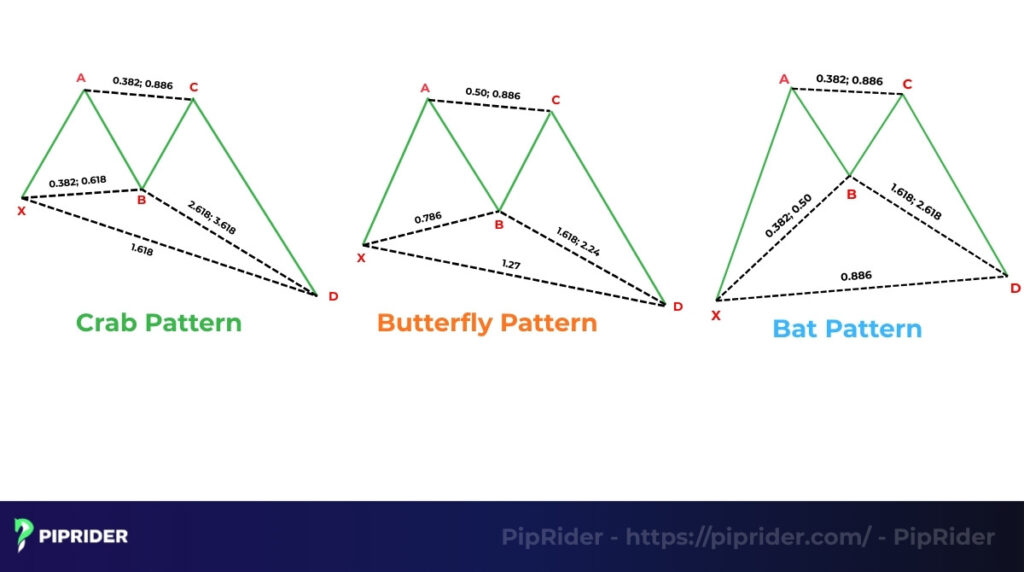
Detailed Comparison of Key Patterns
| Feature | Crab | Butterfly | Bat |
| Pattern Type | Extension (D is beyond X) | Extension (D is beyond X) | Retracement (D is within XA) |
| B-Point Retracement (of XA) | 0.382 to 0.618 | 0.786 | 0.382 to 0.50 |
| C-Point Retracement (of AB) | 0.382 to 0.886 | 0.382 to 0.886 | 0.382 to 0.886 |
| Key D-Point Completion | 1.618 Extension of XA | 1.272 Extension of XA | 0.886 Retracement of XA |
| Psychology | Identifies a reversal after an extreme, overextended price action move. | Identifies a reversal after a significant move beyond the starting point. | Identifies a reversal after a deep retracement within the initial move. |
7. Example Trade and Case Study
Let’s apply these principles to a real-world trade. This case study will walk through a Bearish Crab pattern from identification to completion.
Case Study: Bearish Crab on EUR/AUD
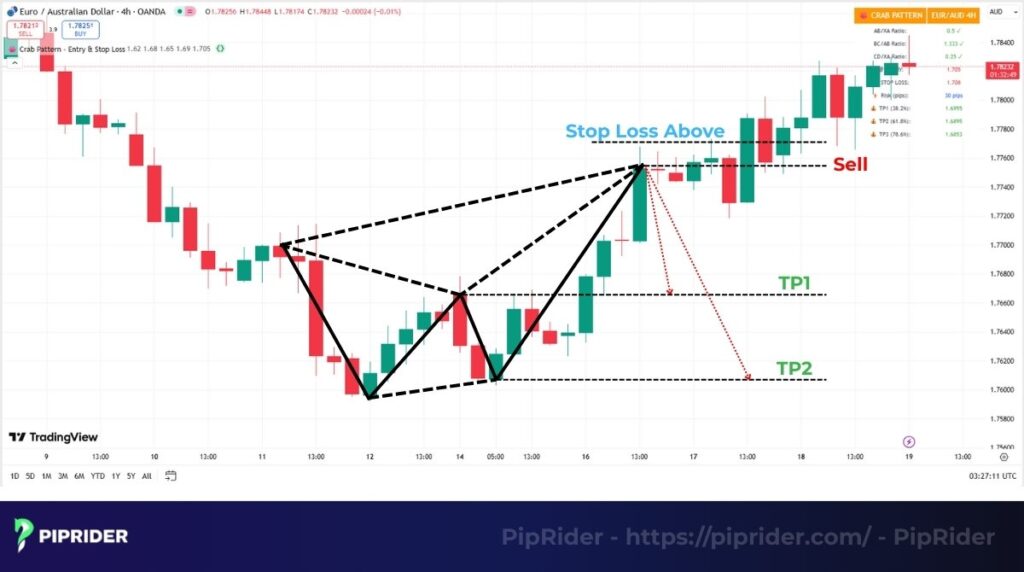
The Setup: On the EUR/AUD 4-hour chart, the pair was in a strong, overextended uptrend. We identified the X, A, B, and C points of a potential Bearish Crab. Using the Fibonacci extension tool, we projected the Potential Reversal Zone (PRZ) at the 1.618 extension of the XA leg. This requires careful price action observation.
The Trade Plan:
- Entry: As the price pushed into the PRZ, a bearish engulfing candle formed, providing our confirmation signal. A short (sell) trade was entered.
- Stop Loss: The stop loss was placed a few pips above the high of the D point in the PRZ.
- Take Profit: Targets were set at the 0.382 and 0.618 Fibonacci retracement levels of the A-D move.
- The Outcome: The market reversed aggressively from the PRZ. The first profit objective was reached quickly, and the stop loss was moved to breakeven. The asset then continued its decline, achieving the second target level for a successful trade.
Lessons Learned: This trade highlights the power of the Crab in identifying reversals in overextended markets. The key to success was patience (waiting for the price to reach the extreme PRZ) and confirmation (waiting for the bearish engulfing candle before entering).
8. Tips for Trading the Crab Successfully
Identifying the Crab is a great skill, but trading it successfully requires a professional mindset. Here are three key tips from our experience to improve your results:
- Look for confluence, especially divergence: A Crab pattern is strongest when confirmed by other signals. Look for RSI or MACD divergence at the D point; this is a powerful sign that momentum is fading. Also, a spike in volume on the reversal candle adds significant confirmation to the setup.
- Use multi-timeframe analysis: Check if the Potential Reversal Zone (PRZ) aligns with a major support or resistance level on a higher timeframe (e.g., daily or weekly). A Crab that completes at a key weekly level is a very high-probability setup.
- Master patience and risk management: The pattern requires extreme patience to wait for the price to reach the deep 1.618 extension. Trust the setup and avoid entering early. Always calculate your position size based on the 1-2% rule to ensure that even if the pattern fails, the loss is manageable.
9. Frequently Asked Questions (FAQs)
10. Conclusion
In conclusion, the Crab Pattern is a powerful but advanced tool that allows traders to identify high-probability reversals at extreme price action levels. With its distinct five-point structure and reliance on the 1.618 Fibonacci extension, it offers a clear, rule-based approach to trading, complete with defined entry, stop-loss, and profit objectives.
However, its main weakness is its rarity and the precision required for identification. We strongly advise that traders always wait for confirmation from other trading indicators and thoroughly practice identifying and trading the pattern on a demo account before risking real capital.


